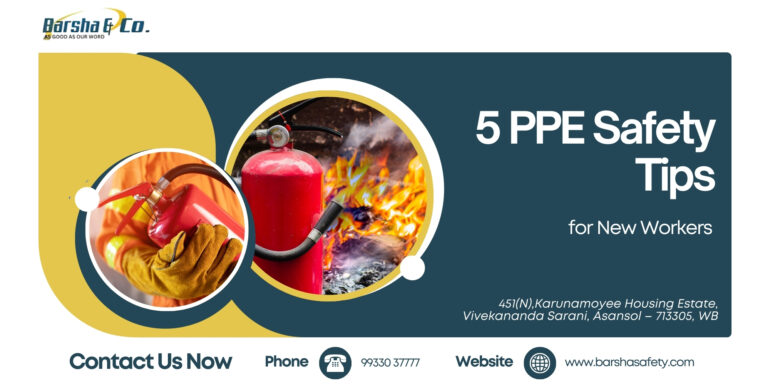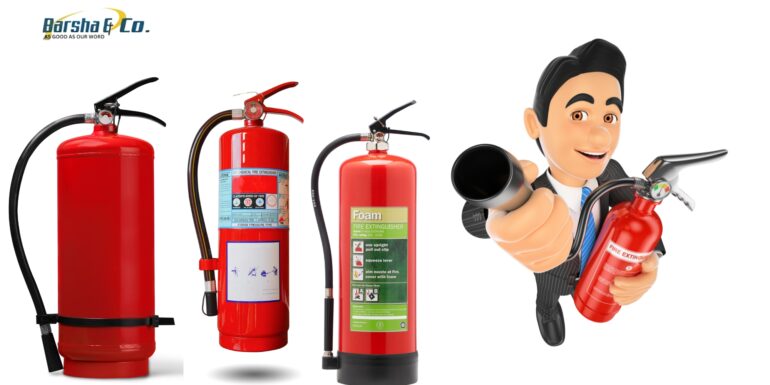Top 5 PPE Safety Tips for New Workers in High-Risk Environments

Entering a high-risk work environment can be intimidating for new workers. Whether it’s a construction site, factory, or any hazardous area, personal protective equipment (PPE) plays a critical role in ensuring safety. PPE is the first line of defense against workplace accidents and injuries. For new workers, understanding the proper use and maintenance of PPE is vital to ensure personal safety and the safety of those around them.

5 PPE Safety Tips for New Workers
Barsha Safety, a leading name in personal protective equipment, specializes in providing high-quality PPE to various industries. Whether it’s protective gloves, helmets, ear muffs, or fire safety equipment, the importance of PPE cannot be understated. In this blog, we will explore the top 5 PPE safety tips every new worker should follow in high-risk environments. Additionally, we’ll highlight the importance of sourcing reliable fire safety equipment from trusted suppliers, such as fire extinguisher suppliers and fire safety equipment manufacturers.
1. Understand the PPE Requirements for Your Job
The first step to staying safe is understanding the specific PPE required for your job. Different jobs and environments require different types of protection. For instance, construction workers need hard hats, safety boots, and protective eyewear, while those working in chemical plants may require specialized gloves and respirators.
Before stepping into a high-risk environment, ensure you are equipped with all the necessary PPE, which can include:
- Helmets
- Earplugs or earmuffs
- Safety goggles or face shields
- High-visibility clothing
- Respiratory protection (masks or respirators)
- Gloves designed for specific hazards
- Protective footwear
Fire safety equipment is another critical element for workers in industries exposed to fire hazards. Make sure your employer has fire extinguishers readily available at the workplace, and these are supplied by credible fire extinguisher suppliers. Regular inspections and maintenance of fire safety equipment are essential to ensure they function properly in emergencies.
Having the right PPE is essential, but it’s just as important to ensure that it fits correctly. Ill- fitting PPE can be uncomfortable, reduce your productivity, and, most importantly, compromise your safety. For example, oversized gloves may reduce your ability to grip objects securely, and loose clothing could get caught in machinery.
2. Ensure Proper Fit and Comfort
The same applies to fire safety equipment such as fire-resistant clothing or face shields, which should offer adequate protection without restricting movement or causing discomfort. Many fire safety equipment manufacturers offer customization to ensure that workers can wear PPE that suits their needs without compromising comfort or functionality.

3. Regularly Inspect and Maintain Your PPE
PPE is only effective if it is in good working condition. Regularly inspecting and maintaining your equipment is crucial. Damaged or worn-out PPE should be replaced immediately, as it can no longer provide the necessary protection.
New workers should learn how to properly inspect their PPE, looking for signs of wear such as:
- Cracks or damage in helmets
- Worn-out soles or stitching in boots
- Torn gloves or clothing
- Foggy or scratched lenses on safety goggles
- Expired or non-functional fire extinguishers
Fire safety equipment, including extinguishers and alarms, should also undergo regular maintenance. It’s essential to work with trusted fire extinguisher suppliers who ensure that extinguishers are refilled, inspected, and replaced on schedule.
4. Receive Proper Training on PPE Usage
Wearing PPE is not enough; knowing how to use it correctly is vital. Improper usage can lead to accidents or injuries. For example, failing to secure a helmet properly or not wearing safety glasses when working with hazardous materials could expose you to significant risks.
Training sessions are critical for new workers in high-risk environments. Many workplaces have safety officers who conduct PPE training. These training programs include:
- How to wear and remove PPE properly
- How to handle hazardous materials safely
- Understanding the limitations of your PPE
- How to use fire safety equipment like extinguishers in case of an emergency
Partnering with experienced fire safety equipment manufacturers is crucial for ensuring that workers receive high-quality, reliable gear. These manufacturers often provide instructional materials and training on how to use fire extinguishers and other fire protection devices properly.
5. Stay Aware of Your Surroundings and Emergency Procedures
PPE alone cannot prevent accidents if you are not aware of the potential hazards around you. New workers must remain vigilant and aware of their surroundings. Always follow safety protocols, and make sure you know the emergency procedures in case of a fire, chemical spill, or other workplace accidents.
Fire hazards are a common concern in high-risk environments. Knowing where fire safety equipment like extinguishers are located and how to use them can save lives. Familiarize yourself with escape routes, fire alarms, and other safety measures provided by your employer. Work with fire extinguisher suppliers to ensure that extinguishers are accessible and functioning at all times.
Conclusion
For new workers in high-risk environments, following PPE guidelines is essential for ensuring personal safety and minimizing workplace accidents. By understanding the types of PPE required, ensuring proper fit, regularly maintaining your gear, receiving proper training, and staying aware of your surroundings, you can significantly reduce the risks posed by hazardous conditions.
At Barsha Safety, we provide reliable and durable PPE solutions to help keep you protected in high-risk environments. We also recommend partnering with reputable fire extinguisher suppliers and fire safety equipment manufacturers to ensure you have top-quality fire protection at your disposal.
Remember, safety comes first—don’t take shortcuts with your personal protective equipment.
Read More: The Importance of Safety Shoes for Civil Engineers
